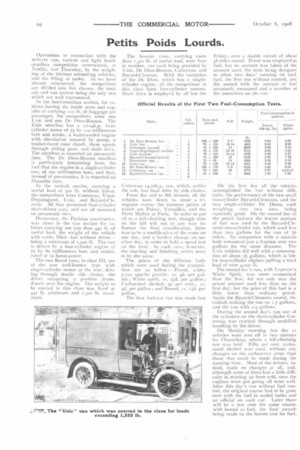Petits Poids Lourds.
Page 14

If you've noticed an error in this article please click here to report it so we can fix it.
Operations in connection with the delivery van, taxicab and light hotel omnibuscompetition commenced, at Neuilly, last Thursday, by the weighing of the thirteen competing vehicles, and the filling of tanks. As we have already announced, the competitors are divided into five classes, the taxicab and van section being the only two which are well represented.
In the hotel-omnibus section, for vehicles haying six inside seats and capable of carrying 110 lb. of baggage per passenger, the competitors were one Unic and one De Dion-Bouton. The Unic omnibus has a 12-14h.p. fourcylinder motor of 75 by Ito millimetres bore and stroke, a water-cooled engine with circulation assured by pump, a leather-faced cone clutch, three speeds through sliding gear, and shaft drive. The omnibus is mounted on pneumatic tires. The De Dion-Boitton omnibus is particularly interesting from the fact that the engine is a single-cylinder one, of too millimetres bore, and that, instead of pneumatics, it is mounted on Ducasble tires.
In the taxicab section, carrying a useful load of soo lb. without driver, the competitors were Cottereau, VinotDeguingand, Unic, and Bayard-Clement. All four presented four-cylinder shaft-driven cars, and are all mounted on pneumatic tires.
Demeester, the Parisian constructor, was alone in the van section for vehicles carrying not less than 44o lb. of useful load, the weight of the vehicle with tanks filled—but without driverbeing a minimum of 1,920 lb. The van is driven by a four-cylinder engine of 72 by 8o millimetres bore and stroke, rated at to horse-power.
The two Royal vans, in class III, are of the now well-known type with single-cylinder motor at the rear, driving through double side chains, the driver occupying a position immediately over his engine. The weight to be carried in this class was fixed at 442 lb. minimum and 1,322 lb. maximum.
The heavier vans, carrying more than 1,322 lb. of useful load, were four in number, one each being provided by Unic, De I)ion-Bouton, Cottereau, and Bayard-Clement. With the exception of the De Dion, which has a singlecylinder engine, all the competitors in this class have four-cylinder motors. Shaft drive is employed by all but the Cottereau 14-1611.p. van, which, u -dike the cab, has final drive by side chains.
From the 2nd to 8th instant, al the vehicles were down to cover a triangular course the extreme points of which are Poissv, Versailles, and the Porte Maillot at Paris. In order to put all to a hill-climbing test, though time on the hill will not in any way intluence the final classification, there was to he a modification of the route on one day, and a further change on another day, in order to hold a speed test on the level. In each cas:e, however, to be the finishing points were The prices of the different fuels which were used during the competition are as follow :—Petrol, o.68o0.720 specific gravity, is. 4d. per gallon ; lVhite spirit, is. 20. per gallon ; Carhurated alcohol, 50 per cent., Is. 4d. per gallon ; and Benzol, is. old. per
Friday, over a double circuit of about 38 miles round. Petrol was employed at fuel, but no account was taken of thf amount used, the tests being designed to allow two days' running on each fuel, the first one without control, and the second with the amount of fuel accurately measured and a member ol the committee on the car.
On the first day all • the vehicles accomplished the run without difficulty, the performance of the two small two-cylinder Bayard-Clements, and the two single-cylinder De Dions, each weighing over two tons, being especially good. On the second day of the petrol fuel-test the lowest amount of fuel was used by the Bayard-Clement two-cylinder van, which used less than two gallons for the run of 76 miles. Its companion with a taxicab body consumed just a fraction over two gallons for the same distance. The Unic vehicles did well with a consumption of about 21 gallons, which is low for four-cylinder engines pulling a total load of over 4,000 lb.
The second day's run, with T.epretre's White Spirit, was more economical than the first, for not only was the actual amount used less than on the first day, but the price of this fuel is a little lower than ordinary petrol. Again the Bayard-Clements scored, the taxicab making the run on 1.7 gallons, and the van with 1.9 gallons.
During the second day's run one of the cylinders on the three-cylinder Cottereau was cracked through unskilful handling by the driver.
On Monday morning last the ii vehicles were sent off in two convoys for Chanteloup, where a hill-climbing test was held. Fifty per cent. carburated alcohol was used, without any changes on the carburetter other than those that could be made during the running time. Most of the drivers, indeed, made no changes at all, and, although some of them had a little difficulty in starting up from cold, once the engines were got going all went well. After this day's run without fuel control, the original course had to be gone over with the fuel in sealed tanks and an official on each car. Later :there will be a test over the same course, with benzol as fuel, the final awards being made on the lowest cost for fuel.


















